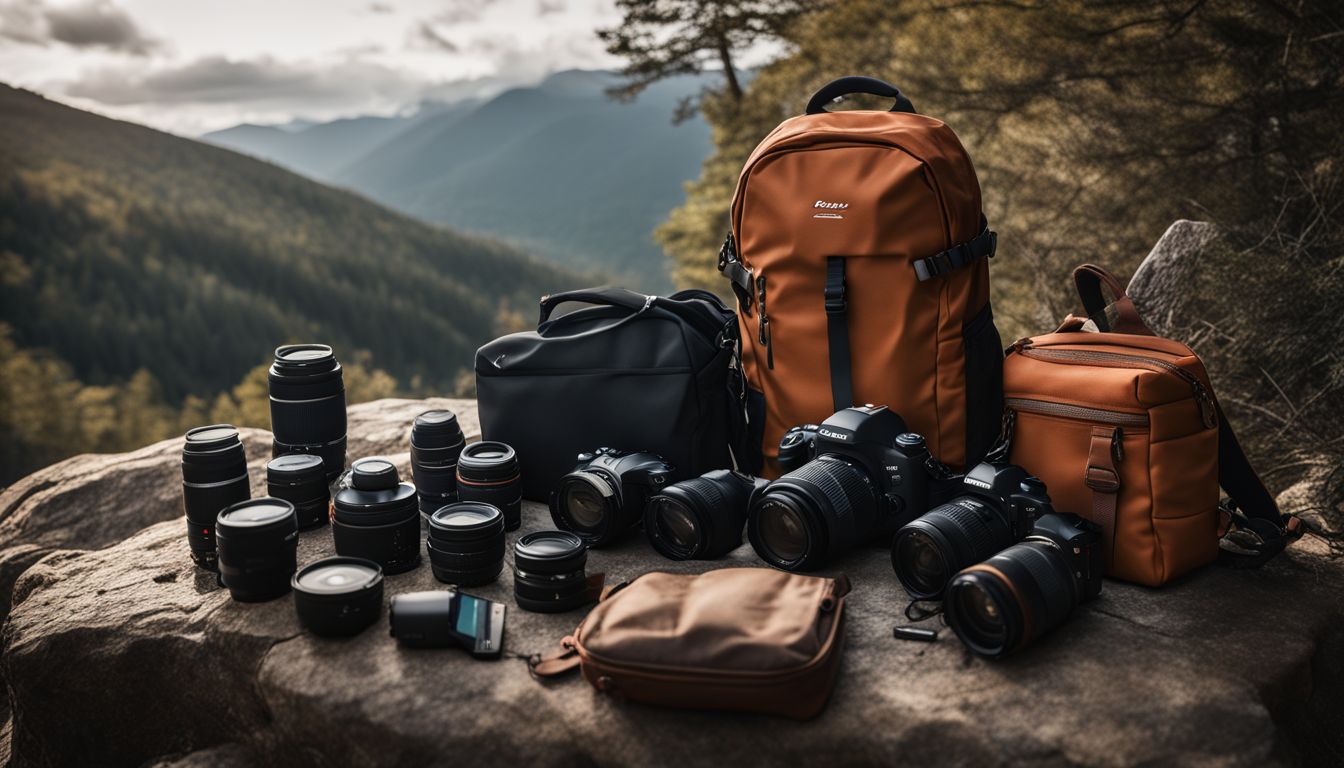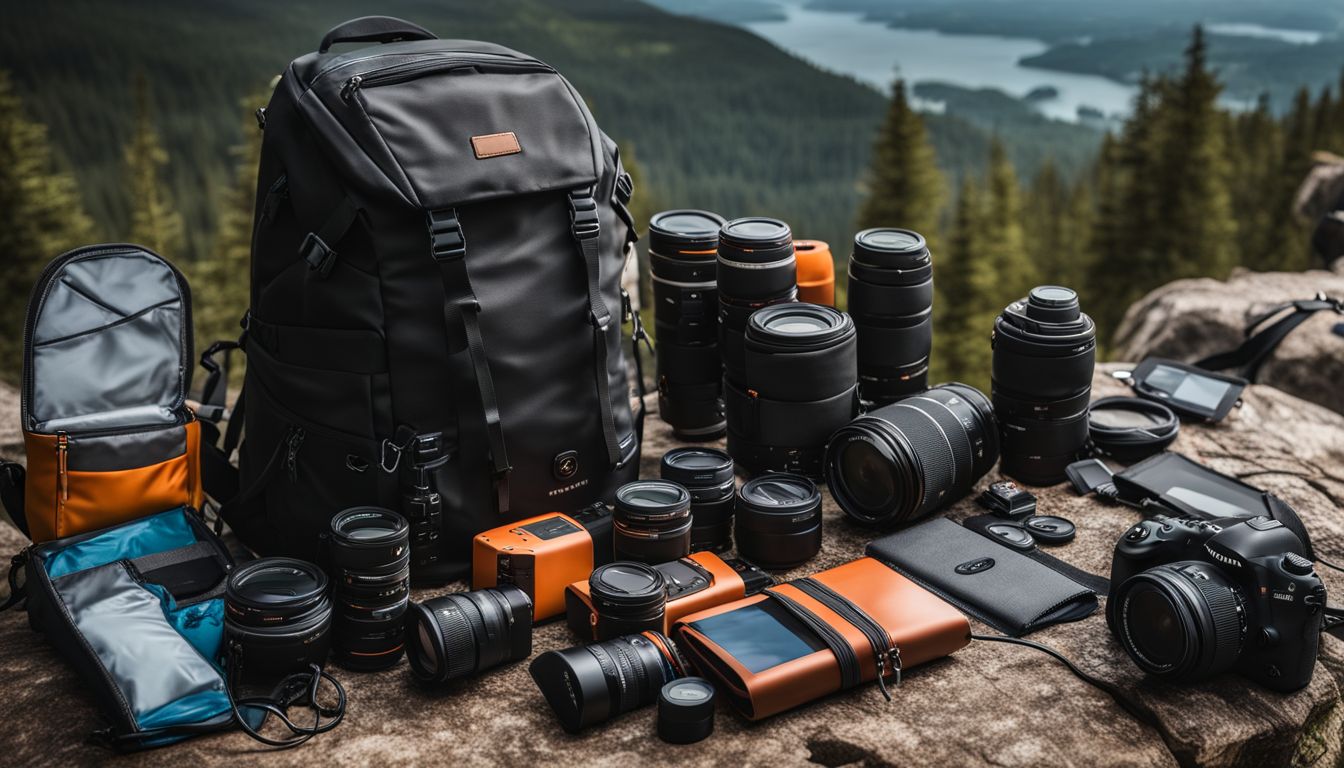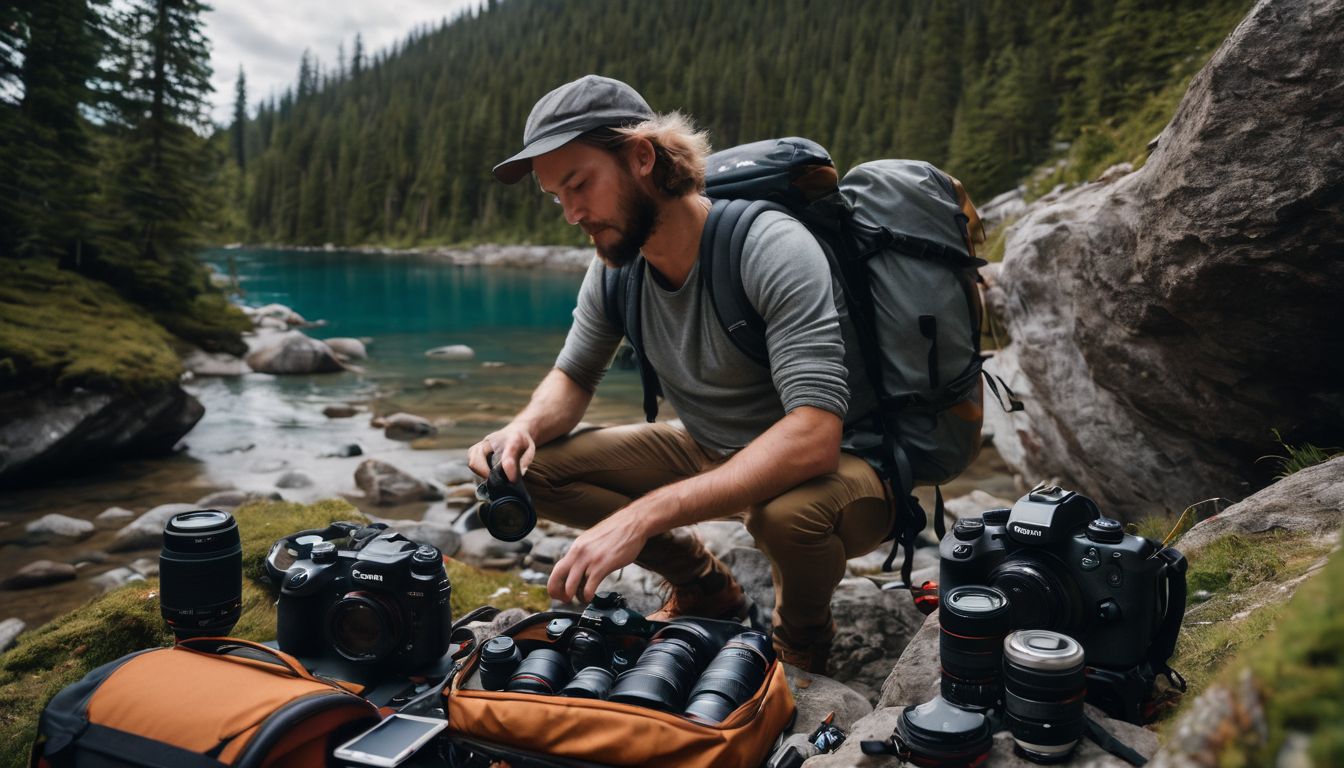Traveling with electronics can often feel like carrying a basket of eggs on a roller-coaster ride; one wrong move and you could have a mess on your hands. As someone who has navigated the unpredictable terrain of outdoor adventures while keeping tech intact, I’ve learned that safeguarding your digital companions is as crucial as staying hydrated.
Whether it’s ensuring smartphones survive bumps or protecting data from prying eyes, experience has taught me the ins and outs of electronic safety in transit.
Surprisingly, even roll-top dry bags can leave your devices vulnerable to moisture — a sobering fact for the avid trekker relying solely on water-resistant sacks. This article will arm you with effective strategies designed to shield your gadgets from damage during your travels.
Get ready to transform how you pack and protect those precious electronic lifelines!
Key Takeaways
- Protect electronic devices in a rucksack from physical damage by using padded compartments, snug cases, and screen protectors to prevent bumps, squashes, scratches, and dents.
- Guard against environmental harm caused by moisture and temperature through the use of silica gel for moisture control, ensuring safe temperatures for electronics, and avoiding exposure to extreme weather conditions.
- Enhance security measures with anti-theft backpacks featuring locking zippers and RFID-blocking technology; consider tracking software and strong passwords to prevent data breaches.
Understanding the Risks to Electronics in a Rucksack

Electronics in a rucksack are exposed to physical damage from impact or pressure, environmental harm from moisture and temperature, as well as security threats from theft or data breach.
It’s important to be aware of these risks in order to take the necessary precautions to keep your devices safe while on the move.
Physical damage from impact or pressure
Your gadgets face tough times inside a backpack. Picture your laptop or iPad getting bumped every time you move. This can happen when your bag hits walls, seats, or desks as you walk.
Even when you’re careful, things like sudden drops or someone squishing your bag in a crowded space can hurt your electronics.
Pressure is another danger for things like phones and flash drives in a rucksack. If you pack too much or sit on your bag, the weight can crush them. A heavy load also puts stress on your shoulders and back which isn’t good for your body either.
To keep laptops and tablets safe from knocks and squashes, give them their own space. Use a padded compartment if possible—think of it as a cozy room where they won’t get hit by other items in the bag.
For extra care, snug cases plus screen protectors are smart moves to guard against scratches and dents during travel adventures.
Environmental harm from moisture and temperature
Moisture and temperature can be big problems for electronics packed in a rucksack. If your gadgets get wet or too hot, they might stop working right. Water can make the parts inside your devices, like chips, break down or even pop open — that’s called popcorning.
When temperatures go up and down a lot, tiny cracks can form in the pieces that hold your device together.
Keeping devices dry and at a safe temperature is important during travel. Use things like silica gel to keep moisture away from phones and laptops. When it’s very cold or hot outside, try not to let electronic things stay in those bad conditions for long.
Bacteria also love damp spots with just the right heat which could mean trouble for stuff packed away with your gear.
Security threats from theft or data breach
Your electronics hold a lot of personal information. When someone steals your laptop, phone, or tablet, it’s not just the device you lose. Your private photos, messages, and even credit card numbers could fall into the wrong hands.
Thieves can use this data to pretend to be you or take your money.
To keep this from happening, treat your gadgets like treasure. Use strong passwords and don’t share them. Think about adding tracking software to find your devices if they go missing.
Keep an eye on your stuff when in public places and never leave them unwatched. If bad people can’t see or get to your electronics easily, they’re less likely to steal them.
Protecting against data breaches is also key. Make sure that any removable storage like USBs are safe because they can be risky too. Put important files in secure cloud storage just in case something happens to your physical device—like getting lost or broken during travel.
Essential Protective Measures for Your Devices

Choose a backpack with padded compartments to provide cushioning and protection for your electronics. Use protective cases and screen protectors to safeguard against scratches and impacts while on the move.
Organize cables and accessories to prevent tangling and potential damage during transit.
Selecting the right backpack with padded compartments
Choosing the right backpack with padded compartments is crucial for keeping your electronics safe while on the go. Here are some essential tips to consider when selecting a backpack for your devices:
- Look for a professional backpack designed with durable materials and padded compartments to protect your electronics from impacts, bumps, and scratches.
- Ensure the backpack has a protective, suspended bottom to safeguard your devices from jostles and provide added shock absorption.
- Consider a backpack with an easily accessible side – access zippered compartment specifically designed to accommodate laptops up to 15 inches in size.
- Opt for an anti-theft backpack equipped with features such as locking zippers and RFID-blocking technology to enhance security for your electronic devices against theft and data breach risks.
- Evaluate the fit, size, material construction, and exterior pockets of the backpack to ensure it meets your specific needs for carrying electronic devices along with other essentials.
Using protective cases and screen protectors
When it comes to keeping your electronics safe in a rucksack, using protective cases and screen protectors is crucial. Here are key measures to consider:
- Protective cases act as a buffer against impacts, providing an extra layer of defense for devices such as laptops, tablets, and cameras.
- Screen protectors shield the display from scratches, cracks, and other damage that can occur during transit or while stored in a backpack.
- Choose screen protectors specifically designed for your device to ensure the perfect fit and optimal protection without compromising touch sensitivity or display quality.
- Consider investing in impact-resistant cases with shock-absorbing materials for added protection against drops and knocks.
- Ensure that the protective case provides a secure fit for your device, minimizing movement within the backpack to prevent potential damage.
Organizing cables and accessories to prevent tangling and damage
When you’re done ensuring that your electronics are in protective cases and screen protectors, it’s time to organize the cables and accessories in your bag to prevent tangling and damage. Here’s how you can do it:
- Use cable organizers: Keep cables organized, tangle-free, and protect devices from damage.
- Store cables and accessories safely in any bag to prevent tangling and damage.
- Organize and manage cables to provide a safe and functional space at home or in the office.
- Utilize bags within a backpack to keep cables organized and prevent tangling.
- Consider multi-end short cables for chargers and a USB-powered multi-USB charger as they are useful for organizing cables in a backpack.
- The Incase Accessory Organizer bag is recommended for organizing cables and small items in a bag.
Advanced Strategies for Keeping Electronics Safe
Waterproofing your electronics with specialized cases or dry bags and implementing security enhancements like locks and tracking devices can provide added protection during transit.
Ready to take your electronic safety to the next level? Read on for more advanced strategies!
Waterproofing with dry bags or specialized cases
To keep electronics safe from water and dust, consider waterproofing them with dry bags or specialized cases. Here are the ways to achieve that:
- Utilize Dry Bags: Select appropriate sizes of dry bags that can hold electronics snugly, protecting them from moisture and dust during transit.
- Opt for Specialized Cases: Invest in specialized waterproof cases designed for specific electronic devices such as laptops, tablets, or cameras to provide an extra layer of protection against environmental elements.
- Verify Submersion Suitability: When selecting dry bags, ensure they are suitable for preventing damage from water and dust but may not be intended for submersion use.
- Consider Brand Options: Explore various brands offering different types of dry bags and specialized waterproof cases tailored to safeguard electronics in a rucksack.
- Prioritize Size Compatibility: Ensure that the chosen dry bag or specialized case is compatible with the size and dimensions of the specific electronic device it will protect.
- Evaluate Durability Features: Look for durable materials, strong seals, and reliable closures when choosing dry bags or specialized waterproof cases for long-lasting protection.
- Explore Additional Features: Some specialized cases may offer additional features such as impact resistance or anti-scratch properties to safeguard electronics during travel.
Temperature control tactics for extreme climates
To ensure the safety and functionality of electronics in extreme climates, it’s crucial to employ effective temperature control tactics. Here are some strategies to protect your devices:
- Keep devices at a stable room temperature to maintain optimal performance and longevity.
- Avoid exposing electronics to direct sunlight or heat sources, as extreme temperatures can significantly impact their functionality.
- Utilize insulated pouches or cases specifically designed for temperature regulation to shield electronics from harsh weather conditions.
- Implement engineering controls such as using thermal insulating materials or specialized cooling systems to protect devices from extreme heat or cold.
- Store electronics in temperature – regulated compartments within your backpack to minimize exposure to fluctuating outdoor temperatures.
- Consider using portable climate control devices if traveling in environments with extremely high or low temperatures to safeguard electronic devices.
Security enhancements like locks and tracking devices
To keep your electronics safe in a rucksack, consider these advanced security measures:
- Use high-quality locks: Invest in sturdy locks specifically designed for backpacks to deter theft and unauthorized access.
- Install tracking devices: Utilize GPS or Bluetooth tracking devices to monitor the location of your rucksack and its contents in real-time.
- Employ digital security features: Use password-protected locking mechanisms or biometric authentication for added layers of protection against data breaches and unauthorized access.
- Customize security settings: Configure remote wipe capabilities on your electronic devices to safeguard sensitive information in case of loss or theft.
- Register with relevant authorities: Take advantage of registration services provided by law enforcement agencies for increased chances of recovering stolen items.
Packing Tips for Electronics and Other Essentials in a Rucksack
When packing electronics in your rucksack, follow these tips for a safe and organized travel experience:
- Store electronics in padded compartments or protective cases to prevent damage from impacts and pressure.
- Use dry bags or specialized cases to protect devices from moisture during transit.
- Keep wires and cables neatly stored in a sunglass case to prevent tangling and potential damage.
- Ensure that all batteries are fully charged before packing electronics for travel to avoid running out of power.
- Pack light by only carrying essential electronics in a well-organized manner to minimize the risk of damage or loss.
Conclusion: Ensuring the Longevity and Integrity of Your Devices
In conclusion, safeguarding your electronics in a rucksack is crucial for their longevity and integrity. The protective measures discussed are practical and easy to implement. Have you considered how these strategies can effectively safeguard your devices during travel? It’s vital to understand the impact of applying these techniques to ensure the safety of your valuable electronics.
Remember that with care and attention while packing, you can protect your laptops, tablets, and cameras from damage. Take action today to secure your devices on the go!
For more tips on how to pack effectively, check out our comprehensive guide on packing food and drinks in your rucksack.
FAQs
1. How can I keep my laptop safe when traveling with it in a rucksack?
To keep your laptop safe, use a dedicated laptop bag inside your rucksack and consider using a cover or sleeve for extra protection.
2. What should I do to protect my phone and Kindle while on the go?
Place your iPhone, mobile phone, or Kindle in padded sections of your carry-on luggage or use protective cases to prevent damage.
3. Are there special bags for carrying electronics like Chromebooks and notebooks?
Yes, you can buy backpacks designed with special compartments to hold devices like Chromebooks and notebooks securely during travel.
4. Can insurance help if my electronics get damaged in my bag?
Insurance companies often offer extended warranties that cover accidental damage to your electronics while they are carried in baggage.
5. What else can I do to make sure my credit cards and point-and-shoot camera are safe in my rucksack?
For added safety for items like credit cards and point-and-shoot cameras, use separate pouches within your rucksack and take preventative measures such as not overpacking which puts pressure on these delicate items.

